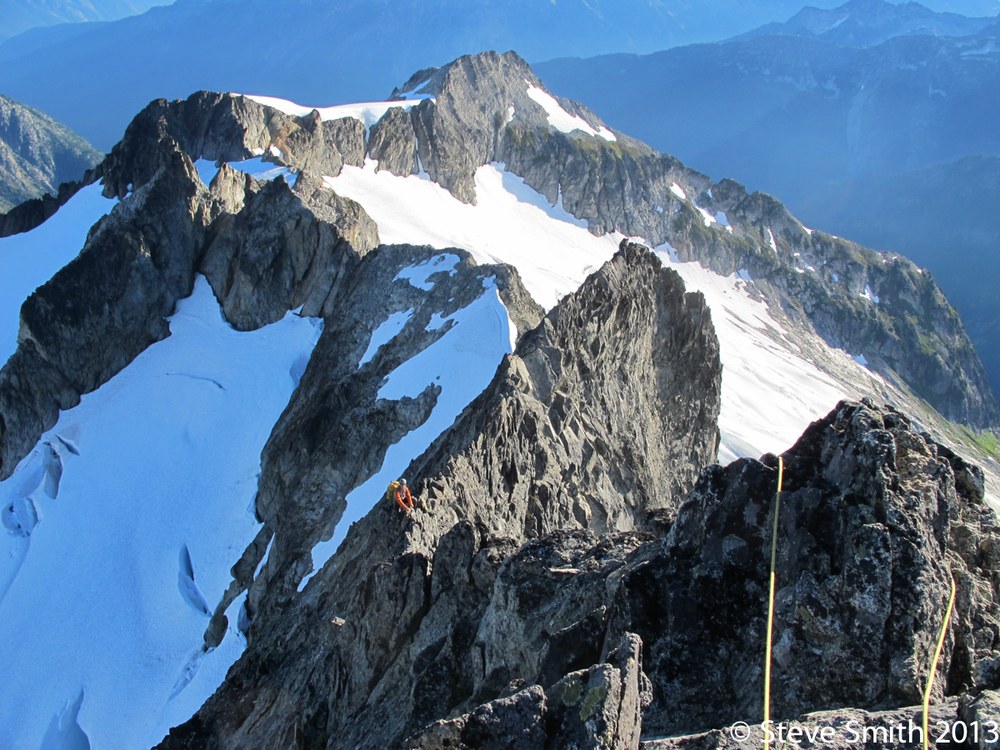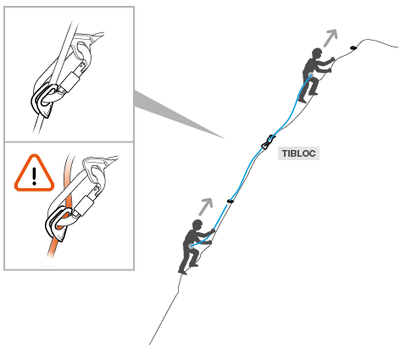
Simul-climbing is an advanced climbing technique where both climbers simultaneously climb while roped together, with pieces of protection continuously placed between them by the lead climber. Given the long and committing nature of many alpine routes in the Cascades, simul-climbing can offer distinct benefits to climbers seeking to balance efficiency and safety moving over vast amounts of terrain; however, the technique has pros and cons, and nuances which warrant attention. It's important to dispel some common misperceptions about this technique.
Make no mistake: Simul-climbing is not a simple technique for beginners, and if not done properly, can actually increase the risks for all climbers on the rope team. Some climbing teams utilize progress-capture devices (PCD) like the Petzl Micro-Traxion to prevent the lead climber getting pulled downward if the follower falls. However, using PCD's in this manner is not recommended by any gear manufacturers, and no tests have been done that validate the use of PCD's for simul-climbing.
Advantages
- Simul-climbing can be more efficient than belayed climbing, and thereby safer in some ways for experienced parties to move along an exposed section of a climb, rather than soloing, or pitching it out traditionally.
- The security of the rope may help climbers move more confidently along a ridge than they would unroped.
- When pitches are longer than the rope length, a bit of simul-climbing can allow the leader to reach a more solid belay anchor than stopping at the end of the belayed pitch.
- Generally speaking, simul-climbing can create more flexibility for the team to move to more advantageous places on a climb rather than stopping at specific intervals defined by the rope’s length.
Disadvantages/concerns
- Simul-climbing may create an illusion of safety when in fact it may be creating more risk for the climber who ends up catching the other’s fall, especially the leader who may end up being pulled backwards if the second falls.
- If you place inadequate protection, you are basically free-soloing while roped together, which doubles each person’s chance of being pulled off in case the other one slips.
- If not done well, simul-climbing can create complications for both the leader and the follower such as rope drag, excessive slack in the system, or unexpected forces as climbers move at different speeds.
- Simul-climbing can present the follower with rockfall as the rope flosses off loose rocks.
- There are no progress-capture devices that have been designed for simul-climbing forces. Manufacturers do not recommend using these devices for this purpose, and some explicitly advise against it.
- Taking a dynamic fall on a PCD could badly damage the sheath of the rope (a fall with a force as low as 3 kilonewtons could sever the sheath of a climbing rope). It would be easy to generate these kinds of forces falling off a traversing ridge climb, for example.
- Accumulated grit or icy conditions can lead a PCD to fail and dramatically reduce the forces needed to destroy a sheath.
- If a second falls and is caught by a PCD, the leader will not be able to give them slack or lower them without transferring the load, a time-consuming process.
- Similarly, if a leader decides to downclimb after placing a PCD, the second will not be able to take in any slack to belay them properly.
- Finally, if you clip a PCD improperly, a fall could sever your rope altogether! (see image below, courtesy of Petzl)

Developing and Fine-Tuning Your simul-climbing skills
- Practice on very easy terrain and work on your systems and teamwork.
- Carry a pack when practicing, just like you would on the actual alpine objective you’re preparing to climb.
- If you think there’s a likelihood of someone falling, better to belay that section rather than rely on a progress-capture device.
- When leading, place gear before your second (follower) arrives at any hard moves, to ensure that both of you are adequately protected.
- Don’t assume simul-climbing is the best approach - it depends on your ability to move smoothly with your partner given the terrain. Work with your partner to develop that teamwork.
- Most simul-climbers shorten the rope to 30m or less to cut down on rope drag and to allow better communication between climbers. Your team may consider using a skinny rope and doubling it, with one climber tied into the middle of the rope. This allows you to simul-climb using a double-rope system, which can help to reduce rope drag if you are familiar with that technique, with the additional benefit of the climbers sharing more of the weight. Alternatively many climbers prefer to have the follower carry that extra length of rope in their pack already rigged to them with a Gri-Gri so that they can easily put a leader on belay if the leader approaches a more difficult section of climbing.
- Remember: If you’re not placing protection between climbers, why are you roped together?
Additional resources
For more about pros and cons of using PCD’s for simul-climbing, see page 218 of Topher Donahue’s Advanced Rock Climbing published by Mountaineers Books.
Other resources:
- Petzl - Manufacturer's info on Mini-Traxion and belaying a second
- Testing of progressive capture devices by Association of Canadian Mountain Guides - watch how fast a rope can sheath!
- John Long and others comment on simul-climbing in a recent Outside Magazine article
Photo: Mountaineers Books Author David Moskowitz and the author simul-climbing on the North Ridge of Forbidden Peak.
Add a comment
Log in to add comments.North Ridge of Forbidden, I think Ari and I spaced about 20m apart on this climb last summer.
More discussion on using TIBLOCs in this application on the Petzl website:
https://www.petzl.com/US/en/Sport/Progression-with-a-taut-rope-using-a-TIBLOC
John Long and others comment on the risks of simul-climbing here: https://www.outsideonline.com/2314826/should-we-reconsider-speed-climbing
 Steve Smith
Steve Smith
